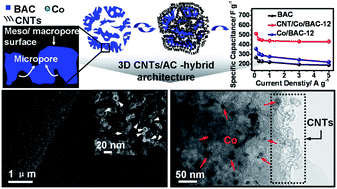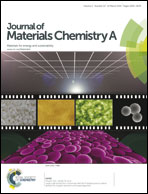A 3D hierarchical hybrid nanostructure of carbon nanotubes and activated carbon for high-performance supercapacitors†
Abstract
Novel carbonaceous hybrid materials are fabricated through the in situ growth of open-tipped mesoporous carbon nanotubes (CNTs) on low-cost activated carbon (AC) substrates with cobalt (Co) nanoparticles as the growing seeds via a chemical vapor deposition process. The CNTs are strongly bonded with the surface of the AC supports using the fine Co nanoparticles (<10 nm) as the joints. The unique three-dimensional hybrid architectures enable the resultant materials to exhibit a considerable specific capacitance of up to 440 F g−1 at 1 A g−1 as well as an excellent rate performance (97% retention ratio at 5 A g−1 compared to 1 A g−1). In addition, the hybrid materials have an impressive cycling stability with an initial capacitance retention of 98.4% after 3000 cycles at 5 A g−1. Besides the high specific surface area, such an excellent capacitive performance is mainly attributed to the combination of (i) the well-dispersed open-tipped CNTs (5–12 nm) that could provide more effective ion channels, (ii) the interconnected CNT conducting networks facilitating the transport of electrons, and (iii) superfine Co nanoparticles (3–9 nm) offering pseudocapacitance, indicating the synergistic effect of both the electrical double layer capacitance and pseudocapacitive reactions.


 Please wait while we load your content...
Please wait while we load your content...